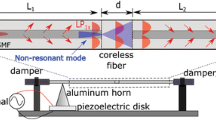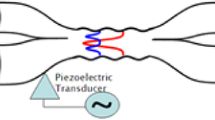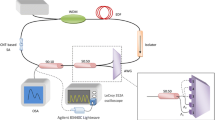Abstract
A new method for Q-switching an all-fiber laser is presented. It is based on induced acoustic long period grating operating on a null coupler, which acts as acoustically controlled tunable output coupler. Q-switching is achieved by switching on and off the acoustic wave in a burst mode, thereby generating laser pulses that are ~400 times shorter than the acoustically controlled coupler’s rise time. Output pulse energy of 22 μJ and temporal width of ~100 ns were measured at a wavelength of 1.54 μm.
Similar content being viewed by others
Avoid common mistakes on your manuscript.
1 Introduction
Fiber lasers systems have long been recognized as compact, efficient and robust, however, relatively few of them were Q-switched. Due to very high gain commonly associated with fiber lasers, Q-switching such systems dictate that very high round trip losses must be induced to suppress lasing and store energy.
Previously, all-fiber laser Q-switching was achieved using an acoustically modulated long-period fiber grating attenuator [1, 2], modulating the Bragg wavelength of the mirrors [3, 4], by stress-induced polarization modulation [5–7], and by a passive all-fiber saturable absorber [8].
In 1995, Culverhouse et al. [9] demonstrated an all-fiber ring laser incorporating a null coupler with acoustically induced long period grating (LPG) for frequency shifting, spectral filtering and output coupling. In their scheme they were able to generate mode-locked picosecond pulses. However, simple Q-switched operation was not reported.
In this work, we present a similar laser configuration to the one presented by Culverhouse et al., but this time attention is focused on a simple Q-switched mode of operation. Relatively short pulses of 100 ns width were obtained despite the relatively slow response of the acoustically controlled null coupler.
2 Principle of the null coupler switch
Birks et al. [10] demonstrated an all-fiber optical switch based on acoustically induced long period grating (LPG) on the so called “null coupler”. A fiber null coupler can be realized by merging and tapering two fibers of different diameters. The difference between the fibers is required to ensure that without the acoustic perturbation there is not any coupling between the two fibers. This occurs since each fiber excites a different mode in the common interaction zone. If adiabaticity is maintained (i.e. the variation in the diameters of the two fibers over coupling length is sufficiently slow), light injected into one of the coupler’s fibers will excite only one mode in the interaction zone. This mode will be coupled back to the same fiber after the interaction zone. Hence, very low coupling between the two fibers occurs regardless of the wavelength. However, if an LPG is induced in the interaction zone, light can be coupled from the original fiber mode to the mode associated with the second fiber. The required LPG period (L B) for coupling between two optical modes with propagation constants (β e) and (β o) is given by.\( L_{\text{B}} = \frac{2\pi }{{\beta_{e} - \beta_{0} }} \) [11]. The acoustic resonant frequency required to form a grating period L B is \( f = \frac{{\pi Rc_{\text{ext}} }}{{L_{\text{B}}^{2} }} \), where R is the fiber radius and c ext is the speed of extensional acoustic waves in silica (5,760 m/s) [12]. Since β e and β o are wavelength dependent, the grating’s period, and thus, the resonant acoustic frequency will define the coupling wavelength. The coupling ratio between the two fibers is determined by the acoustic amplitude of the LPG and the length of the interaction zone.
3 Experimental setup
The experimental setup is described in Fig. 1. A laser diode was used to side pump, an Er:Yb doped double clad fiber (Nufern SM-EYDF-6/125-HE) at 976 nm. The doped fiber was spliced to an isolator, which imposed unidirectional lasing. The output terminal of the isolator was spliced to the input terminal of a null coupler. The null coupler was prepared from two passive single mode fibers (SMF28e) using the heat and pull technique with a hydrogen flame. Prior to fusion, one of the fibers was pre-tapered from a 125 μm diameter to a diameter of 60 μm (the other was not pre-tapered). At the end of the process the null coupler was obtained, having a circular waist of ~22 μm and length of ~20 mm. To induce acoustic waves in the coupler, a piezoelectric transducer (PZT) controlled by a function generator was attached to the coupler at the large diameter area. The fiber was glued to a small segment of a 300 μm fiber at a perpendicular orientation to its longitude axis. The small fiber segment which was glued to a multilayer PZT as depicted in Fig. 2. In this way, the vertical vibrations of the PZT were coupled to flexural acoustic wave in the fiber through the single point in which the two fibers intersect.
The end facets of the coupler’s output fibers were angle cleaved, to prevent back reflection from the fibers’ end. The pre-tapered fiber terminal was spliced back to the side coupler to close the ring laser resonator loop.
The fiber null coupler was used in such a way that while the PZT was turned off there was no coupling between the two fibers, hence the laser was switched off. As the PZT was turned on, the acoustically induced LPG was generated; light was coupled from one fiber to the other and the ring resonator loop was closed. Since the coupling efficiency per wavelength between the channels is determined by the induced LPG parameters, the feedback intensity and spectrum can be controlled by changing the amplitude and the period of the grating, respectively. It should be noted that the very high gain (~40) associated with this laser dictates that very high cavity losses should be induced to suppress lasing. To suppress any measurable feedback into the resonator in the “off” state, the null coupler was constructed from a pair of mismatched fibers. Such a design enabled a very high isolation (<−50 dB) but came at the expense of elevated access losses due to degraded adiabaticity in the pre-tapered fiber channel (residual coupling to high-order modes that are not coupled back to the fiber core).
4 Experimental results
Figure 3 depicts the transmission spectral trace of the two null coupler’s output terminals for different acoustic frequencies, under broadband illumination of the input terminal. The spectral shift as a function of frequency is associated with the wavelength-dependent propagation constant of the two coupled modes. The transmission intensity dependence upon frequency is attributed mainly to the acoustic response of the PZT.
Figure 4 depicts the transmission of the two output terminals of the null coupler at different acoustic vibration amplitudes. The amplitudes of the acoustic vibration were controlled by varying the induced voltage upon the PZT. The solid line that follows the 60 μm coupler output is a squared sine fit, which is approximately the expected trend according to the coupled mode theory [13]. The relatively high excess loss of the coupler is attributed to the optical and acoustic polarization mismatch [12], as well as to the undesired coupling to high order modes, as was previously discussed.
Variable reflectivity and wavelength selectivity are, therefore, achieved by controlling the amplitude and frequency of the acoustic wave. This scheme forms an acoustically controlled output coupler for a ring laser cavity. To evaluate the temporal response of the switch, the acoustic harmonic modulation at 890 kHz was turned on and then off at the fastest achievable rise time/fall time. Figure 5 depicts a measured temporal response of ~40 μs (for a transition from 10 to 90 % of transmission), corresponding to a sound velocity of 500 m/s. This is in reasonable agreement with the predicted velocity of 420 m/s for the 22 μm diameter coupler [14].
Q-switched operation of the laser was achieved by switching on and off the acoustic wave in a burst form. When turned off, the effective output coupler has zero reflection, allowing population inversion build-up. Once anacoustic wave is induced, the reflectivity, as well as the quality factor of the resonator, increases and a laser pulse is created. Pulses at wavelength of 1.54 μm with energy of 22 μJ and temporal width of 100 ns were measured at repetition rates of 1 kHz. The pulse energy was limited by the intracavity losses. For comparison, assuming cavity losses of 5 %, the expected pulse energy is 39 μJ [15, 16]. It is interesting to note that the pulse width in the Q-switched mode is ~400 times shorter than the acoustic response time of the coupler. The temporal response of the laser pulse following switch burst duration of 1.1 μs is shown in Fig. 6. As can be seen, a laser pulse was generated prior to the build-up time of the acoustic LPG. This implies that the acoustic wave front induces deformations that are strong enough to close the resonator loop and create short pulses.
On the other hand, the fact that the LPG’s build-up time is longer than the pulse duration imposes limitation on the wavelength’s tunability while Q-switching. This conclusion was experimentally verified; while wavelength tunability was permitted in a CW mode of operation (as can be seen in Fig. 7), the laser was almost insensitive to the acoustic modulation frequency while Q-switched. Wavelength tunability in Q-switch operation could probably be achieved by incorporating a second LPG element operating at a constant frequency in the laser cavity acting as a dynamic filter.
5 Conclusions
In this paper, we presented and experimentally demonstrated a new concept for all-fiber Q-switched lasers, based on acoustically controlled null coupler. This was enabled by a rather surprising result—by operating the acoustically controlled coupler in a burst mode, the laser pulses are ~400 times shorter than the coupler’s rise time. Q-switched operation with pulse energy of 22 μJ, pulse width of 100 ns and repetition rate of 1 kHz was achieved. Higher pulse energies are expected for reduced cavity losses. Nevertheless, even with the relatively large intracavity losses in the system, reasonable extraction efficiency was achieved due to the high laser gain and the associated need for low resonator feedback. Tunability at CW operation mode was achieved, while in Q-switch mode another dynamic filter is required to enable tunability.
References
D.W. Huang, W.F. Liu, C.C. Yang, IEEE Photon. Technol. Lett. 12, 1153 (2000)
D. Zalvidea, N.A. Russo, R. Duchowicz, M. Delgado-Pinar, A. Díez, J.L. Cruz, M.V. Andrés, Opt. Commun. 244, 315 (2005)
W.F. Liu, I.M. Liu, L.W. Chung, D.W. Huang, C.C. Yang, Opt. Lett. 25, 1319 (2000)
R.J. Williams, N. Jovanovic, G.D. Marshall, M.J. Withford, Opt. Express 18, 7714 (2010)
J. Geng, Q. Wang, J. Smith, T. Luo, F. Amzajerdian, S. Jiang, Opt. Lett. 34, 3713 (2009)
M. Leigh, W. Shi, J. Zong, J. Wang, S. Jiang, N. Peyghambarian, Opt. Lett. 32, 897 (2007)
Y. Kaneda, Y. Hu, C. Spiegelberg, J. Geng, S. Jiang, in Proceedings of Advanced Solid-State Photonics, vol. 94 of 2004 OSA Trends in Optics and Photonics Series (Optical Society of America, 2004),postdeadline paper PD5
A.S. Kurkov, Ya.E Sadovnikova, A.V. Marakulin, E.M. Sholokhov, Laser Phys. Lett. 7, 795 (2010)
D. O. Culverhouse, D. J. Richardson, T. A. Birks, P. St. J. Russell, Opt. Lett. 20, 2381(1995)
T.A. Birks, S.G. Farwell, P.St.J. Russell, C.N. Pannell, Opt. Lett. 19, 1964 (1994)
J.N. Blake, B.Y. Kim, H.E. Engan, H.J. Shaw, Opt. Lett. 12, 281 (1987)
S.G. Farwell, M.N. Zervas, R.I. Laming, J. Lightwave Technol. 16, 1671 (1998)
W.P. Huang, J. Opt. Soc. Am. A11, 963 (1994)
R. Feced, C. Alegria, M.N. Zervas, R.I. Laming, IEEE J. Sel. Top. Quantum Electron. 5, 1278 (1999)
W. Koechner, Solid-State Laser Engineering, 6th edn. (Springer, Berlin, 2006)
Y. Sintov, Y. Glick, T. Koplowitch, Y. Nafcha, Opt. Commun. 281(5), 1162 (2008)
Author information
Authors and Affiliations
Corresponding author
Rights and permissions
About this article
Cite this article
Berg, Y., Goldring, S., Pearl, S. et al. Q-switching an all-fiber laser using acousto-optic null coupler. Appl. Phys. B 111, 425–428 (2013). https://doi.org/10.1007/s00340-013-5351-3
Received:
Accepted:
Published:
Issue Date:
DOI: https://doi.org/10.1007/s00340-013-5351-3











